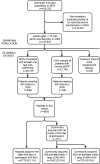KDIGO-based acute kidney injury criteria operate differently in hospitals and the community-findings from a large population cohort
- PMID: 27190340
- PMCID: PMC4876971
- DOI: 10.1093/ndt/gfw052
KDIGO-based acute kidney injury criteria operate differently in hospitals and the community-findings from a large population cohort
Abstract
Background: Early recognition of acute kidney injury (AKI) is important. It frequently develops first in the community. KDIGO-based AKI e-alert criteria may help clinicians recognize AKI in hospitals, but their suitability for application in the community is unknown.
Methods: In a large renal cohort (n = 50 835) in one UK health authority, we applied the NHS England AKI 'e-alert' criteria to identify and follow three AKI groups: hospital-acquired AKI (HA-AKI), community-acquired AKI admitted to hospital within 7 days (CAA-AKI) and community-acquired AKI not admitted within 7 days (CANA-AKI). We assessed how AKI criteria operated in each group, based on prior blood tests (number and time lag). We compared 30-day, 1- and 5-year mortality, 90-day renal recovery and chronic renal replacement therapy (RRT).
Results: In total, 4550 patients met AKI e-alert criteria, 61.1% (2779/4550) with HA-AKI, 22.9% (1042/4550) with CAA-AKI and 16.0% (729/4550) with CANA-AKI. The median number of days since last blood test differed between groups (1, 52 and 69 days, respectively). Thirty-day mortality was similar for HA-AKI and CAA-AKI, but significantly lower for CANA-AKI (24.2, 20.2 and 2.6%, respectively). Five-year mortality was high in all groups, but followed a similar pattern (67.1, 64.7 and 46.2%). Differences in 5-year mortality among those not admitted could be explained by adjusting for comorbidities and restricting to 30-day survivors (hazard ratio 0.91, 95% confidence interval 0.80-1.04, versus hospital AKI). Those with CANA-AKI (versus CAA-AKI) had greater non-recovery at 90 days (11.8 versus 3.5%, P < 0.001) and chronic RRT at 5 years (3.7 versus 1.2%, P < 0.001).
Conclusions: KDIGO-based AKI criteria operate differently in hospitals and in the community. Some patients may not require immediate admission but are at substantial risk of a poor long-term outcome.
Keywords: acute kidney injury; delivery of health care; epidemiology; primary health care; survival analysis.
© The Author 2016. Published by Oxford University Press on behalf of ERA-EDTA.
Figures



References
-
- Chertow GM, Burdick E, Honour M et al. . Acute kidney injury, mortality, length of stay, and costs in hospitalized patients. J Am Soc Nephrol 2005; 16: 3365–3370 - PubMed
-
- Kidney Disease: Improving Global Outcomes (KDIGO) Acute Kidney Injury Work Group. KDIGO clinical practice guideline for acute kidney injury. Kidney Inter Suppl 2012; 2: 1–138
-
- Stewart J, Findlay G, Smith N et al. . Adding Insult to Injury: A Review of the Care of Patients who Died in Hospital with a Primary Diagnosis of Acute Kidney Injury. London: National Confidential Inquiry into Patient Outcome and Death, 2009
-
- NHS England. Patient Safety Alert on Standardising the Early Identification of Acute Kidney Injury, 2014. http://www.england.nhs.uk/2014/06/09/psa-aki/ (16 October 2014, date last accessed) - PubMed
MeSH terms
Grants and funding
LinkOut - more resources
Full Text Sources
Other Literature Sources
Medical
Miscellaneous

